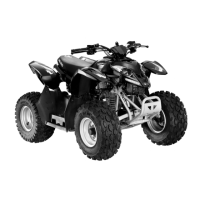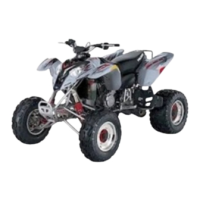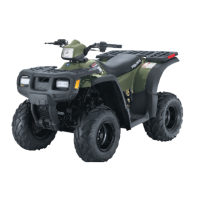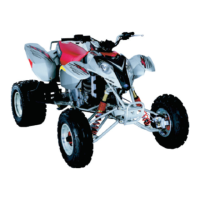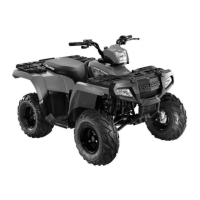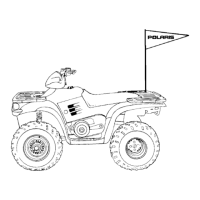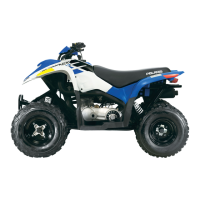FUEL SYSTEM/CARBURETION
3.12
COLD WEATHER STARTING
PROCEDURE
Youth ATV Cold Weather Starting Procedure (Less Than 40_F(4_C))
NOTE: Polaris Youth ATVs are factory jetted for 40--80_F(4--27_C).
1. If the ATV has not been driven recently or has “summer
gas”, replace the fuel in the tank with “winter gas” and drain
the fuel from the float bowl until it has fresh fuel (photo 1).
2. Turn key and ignition to the “on position’ and engage
starter for 5 seconds.
3. If the engine does not start, wait 5 seconds for the choke
circuit to re--fill.
4. If the battery is not charged enough to rotate the engine
effectively, place a charger on the battery or use the kick
start lever.
5. Engage the starter again for 5 seconds or kick start. Re-
peat this procedure up to 10 times.
6. If engine doesn’t fire after several attempts perform the
following manual choke procedure.
MANUAL CHOKE PROCEDURE
1. Block the end of the air inlet tube to the air box and en-
gage the starter for 5 seconds (photo 2).
2. If the engine doesn’t start, wait 5 seconds for the choke
circuit to re--fill.
3. Engage starter again for 5 seconds.
4. If the battery is not charged enough to rotate the engine
effectively, place a battery charger on the battery or use the
kick start lever.
5. If engine will not start, check spark plug for fouling.
DEALER SET--UP FUEL SYSTEM RECOMMENDATIONS
1. Loosen carburetor drain plug screw and drain old fuel (photo1).
2. Remove fuel line at carburetor and pressurize the fuel tank or vacuum the fuel line hose to make cer-
tain there is a fresh and consistent fuel supply to the carburetor.
3. Make certain the fuel line from the fuel petcock is routed below the oil injection tank and runs “downhill”
to the carburetor.
4. Make certain the fuel tank vent near the fule cap is not pinched. To eliminate pinching, it may be nec-
essary to lower the front fuel tank mounting tab so the bottom surface of the tab is level with the upper
frame tubes.
5. The fuel passages of the youth models (i.e. petcock, pilot jet, needle jet and seat, main jet, and choke
circuit) are smaller compared to the full size ATVs, so it is even more important to use fuel that is free of
contamination. If the ATV runs poorly, it may be necessary to remove and disassemble the carburetor
and petcock to make certain all fuel passages are free from contamination.
Photo 1
Photo 2
Air Inlet Tube
Enfocus Software - Customer Support
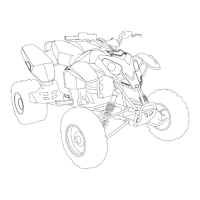
